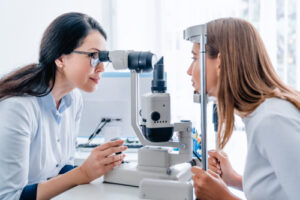Dry eye syndrome is a common eye condition that can cause discomfort, redness, and other symptoms. At St. Luke’s, our experienced eye doctors are committed to providing comprehensive dry eye care and helping you achieve optimal eye health.
What is Dry Eye Syndrome?
Dry eye syndrome is a very common eye condition that affects the cornea, the transparent dome at the front of your eye. Dry eye syndrome is a chronic and often progressive condition that occurs when the eyes don’t produce enough tears, or the tears evaporate too quickly.

This can result in discomfort, inflammation, and damage to the eye’s surface. Dry eye syndrome can affect anyone, but it’s more common in older adults and those who wear contact lenses, have certain medical conditions or take specific medications. Dry eyes can also occur due to prolonged periods of screen time, exposure to dry air or wind, and hormonal changes during pregnancy or menopause. Additionally, some people may be genetically predisposed to dry eyes. If dry eye symptoms persist and start interfering with daily activities, it is best to visit your eye doctor at St. Luke’s for an evaluation. Preventative measures such as taking frequent breaks during screen time, avoiding exposure to dry environments, and wearing protective eyewear in windy conditions may also help reduce the occurrence of dry eyes. Drinking enough water and maintaining a healthy diet can also support overall eye health. Understanding the causes of dry eyes and taking steps to manage the condition can improve comfort and prevent long-term damage to the eyes.
What are the Most Common Symptoms of Dry Eye?

Dry eye syndrome can cause different symptoms in different people. Some of the most common symptoms of dry eye include:
- A gritty or sandy feeling in the eyes
- Burning or stinging sensation
- Redness in the eyes
- Blurred vision
- Sensitivity to light
- Increased tearing
- Eye fatigue or strain
- Difficulty wearing contact lenses
- Itching or irritation in the eyes
Symptoms of dry eye can vary in severity and frequency. They may also worsen in certain environments, such as in dry or windy weather, in air-conditioned or heated rooms, or when using digital devices for long periods.
How Do Eye Doctors Diagnose Dry Eye?
If you are experiencing symptoms of dry eye, the first step to eliminating those symptoms is to visit your eye doctor at St. Luke’s for an evaluation, so they can determine the root cause of your symptoms. The eye doctors at St. Luke’s utilize a variety of tests in combination with a thorough eye exam to diagnose dry eyes.
History of Symptoms
Your eye doctor will begin by asking about your symptoms. They may also ask you how long you have been experiencing these symptoms and if they worsen after performing certain activities like computer work.
Eye Exam
Your eye doctor will then examine your eyes using a special microscope called a slit-lamp, looking for signs of dryness, inflammation, and damage to the cornea.

Allergy Testing
At St. Luke’s, our eye doctors also perform a skin test to determine what allergens may trigger an allergic response. Determining if your dry eye symptoms are related to allergies will help your eye doctor create a treatment plan tailored to the appropriate cause.
Inflammadry Testing
This test looks for MMP9, an inflammatory marker that is consistently elevated in the tears of those with dry eye disease. Elevated levels of MMP9 indicate inflammation in the eye.
Osmolarity Testing
Osmolarity testing measures the salt content of tears. If the salt concentration is too high, it can indicate dry eye.
SJO Test
Those with Sjogren’s syndrome, an autoimmune disorder, may be more likely to develop dry eye syndrome. In some cases, your eye doctor at St. Luke’s may recommend an SJO test to determine if you have Sjogren’s syndrome.
What Treatment Methods Are Available For Dry Eye?
At St. Luke’s, our eye doctors are dedicated to providing patients with the most advanced and up-to-date treatments available. Here are some of the treatment methods offered at St. Luke’s:
Amniotic Membrane Treatments
This treatment involves the use of amniotic membranes to promote healing and reduce inflammation. The membranes are placed on the surface of the eye and can help restore the natural balance of the tear film. At St. Luke’s, our eye doctors offer Prokera and Bio D Optix.
BlephEx
BlephEx is a specialized treatment for the lids and lashes that removes inflammatory debris associated with blepharitis. It is an in-office treatment that involves the use of a handheld device that removes debris and bacteria from the eyelids and lashes.
Immunotherapy
This treatment involves the use of sublingual drops specifically formulated to build resistance to your specific allergies. This can help reduce the symptoms of dry eye caused by allergic reactions.
Prescription and OTC Medications

At St. Luke’s, our eye doctors also recommend prescription or over-the-counter medications in some cases. If you have blepharitis, your eye doctor may recommend Avenova, which is a medicated eyelid wash that helps combat blepharitis. Avenova is available by prescription or over the counter. For those with advanced dry eye, your eye doctor may recommend prescription eye drops to help reduce inflammation. Restasis is a prescription anti-inflammatory drop that helps increase the eyes’ natural ability to produce tears. Xiidra is another prescription eye drop that treats the signs and symptoms of dry eye disease.
Punctal Plugs
This treatment involves the insertion of small plugs into the tear drainage system to keep more tears in the eye. This can improve the symptoms of dry eye. Since there are various treatment methods available for dry eye syndrome, the best approach will depend on the underlying cause of the condition. It is important to consult with an eye doctor to determine the most appropriate treatment plan. Are you experiencing signs or symptoms of dry eye?
Schedule an appointment at one of our 7 locations today!
 This can result in discomfort, inflammation, and damage to the eye’s surface. Dry eye syndrome can affect anyone, but it’s more common in older adults and those who wear contact lenses, have certain medical conditions or take specific medications. Dry eyes can also occur due to prolonged periods of screen time, exposure to dry air or wind, and hormonal changes during pregnancy or menopause. Additionally, some people may be genetically predisposed to dry eyes. If dry eye symptoms persist and start interfering with daily activities, it is best to visit your eye doctor at St. Luke’s for an evaluation. Preventative measures such as taking frequent breaks during screen time, avoiding exposure to dry environments, and wearing protective eyewear in windy conditions may also help reduce the occurrence of dry eyes. Drinking enough water and maintaining a healthy diet can also support overall eye health. Understanding the causes of dry eyes and taking steps to manage the condition can improve comfort and prevent long-term damage to the eyes.
This can result in discomfort, inflammation, and damage to the eye’s surface. Dry eye syndrome can affect anyone, but it’s more common in older adults and those who wear contact lenses, have certain medical conditions or take specific medications. Dry eyes can also occur due to prolonged periods of screen time, exposure to dry air or wind, and hormonal changes during pregnancy or menopause. Additionally, some people may be genetically predisposed to dry eyes. If dry eye symptoms persist and start interfering with daily activities, it is best to visit your eye doctor at St. Luke’s for an evaluation. Preventative measures such as taking frequent breaks during screen time, avoiding exposure to dry environments, and wearing protective eyewear in windy conditions may also help reduce the occurrence of dry eyes. Drinking enough water and maintaining a healthy diet can also support overall eye health. Understanding the causes of dry eyes and taking steps to manage the condition can improve comfort and prevent long-term damage to the eyes. Dry eye syndrome can cause different symptoms in different people. Some of the most common symptoms of dry eye include:
Dry eye syndrome can cause different symptoms in different people. Some of the most common symptoms of dry eye include:
 At St. Luke’s, our eye doctors also recommend prescription or over-the-counter medications in some cases. If you have blepharitis, your eye doctor may recommend Avenova, which is a medicated eyelid wash that helps combat blepharitis. Avenova is available by prescription or over the counter. For those with advanced dry eye, your eye doctor may recommend prescription eye drops to help reduce inflammation. Restasis is a prescription anti-inflammatory drop that helps increase the eyes’ natural ability to produce tears. Xiidra is another prescription eye drop that treats the signs and symptoms of dry eye disease.
At St. Luke’s, our eye doctors also recommend prescription or over-the-counter medications in some cases. If you have blepharitis, your eye doctor may recommend Avenova, which is a medicated eyelid wash that helps combat blepharitis. Avenova is available by prescription or over the counter. For those with advanced dry eye, your eye doctor may recommend prescription eye drops to help reduce inflammation. Restasis is a prescription anti-inflammatory drop that helps increase the eyes’ natural ability to produce tears. Xiidra is another prescription eye drop that treats the signs and symptoms of dry eye disease.
